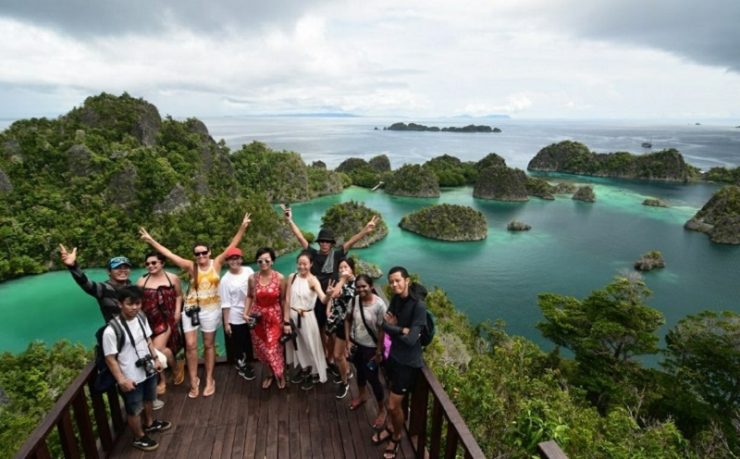THE COVID-19 pandemic since the beginning of 2020 has resulted in a decline in foreign tourist arrivals. Until the end of 2021, foreign tourist visits only reached 1.58 million people, a decrease of 60.98% compared to 2020. Domestic tourists are also the hope and the driving force of Indonesian tourism during the pandemic.
According to the Minister of Tourism and Creative Economy, Sandiaga Uno in a virtual discussion of the Urban Forum – Regional Journalists Forum (FORWADA), Tourism & Hospitality Outlook 2022 ‘New Normal Time to Wake Up from Deep Sleep’, Thursday (1/20) said in the midst of this pandemic, there is a glimmer of hope, namely the high enthusiasm of domestic tourists who are the driving wheels of the tourism sector and the creative economy at this time.
“In 2021, the Central Statistics Agency recorded data on the movement of domestic tourists to increase by 12% compared to 2020. Not only that, there was an increase in tourism foreign exchange by 4% compared to 2020, which was US$0.32 billion to US$0.36 billion. and the contribution of tourism’s gross domestic product (GDP) is estimated to increase by 37.4% from the percentage in 2020 to reach 4.2% in 2021,” he said.
He explained that the export value of creative and creative products is estimated to increase to reach US$20.58 billion and the added value of the creative economy in 2021 will also increase to the level of IDR1,273 trillion.
According to Sandiaga, the movement of domestic tourists will be a mainstay in the recovery of the national tourism sector in 2022 with a target of 260 million-280 million movements. It is estimated that the contribution of the tourism sector to the 2022 National GDP will reach 4.3%. Slightly higher than the estimated achievement in 2021, which is 4.2%.
In addition, he continued, in terms of added value, the creative economy is targeted to reach IDR 1,236 trillion in 2022. The export value of creative products is targeted to reach US$21.28 billion. Slightly better than the estimated 2021 achievement of US$20.48 billion.
“The impact of this growth will certainly expand the number of jobs in the tourism sector and the creative economy. In 2022, we are targeting to create 400 thousand new quality jobs in the tourism sector. Meanwhile, the creative economy will grow more than 600-700 thousand jobs, which will be supported by the leading sectors, namely culinary, craft, and fashion,” he said.
Sandiaga added that if you look at the positive side, the pandemic has actually accelerated the paradigm shift in tourism development from quantity tourism to quality and sustainable tourism as directed by the President Jokowi in 2019.
“We emphasize the principle of sustainable tourism which depends on what we offer to tourists according to future tourism trends, namely more personalized, customized, localized and smaller in size,” he remarked.
One of the important variables in quality tourism is the provision of adequate tourism infrastructure. Tourists will certainly spend more money (spending) for a quality destination, both in terms of 3A (attractions, access and amenities) and supporting infrastructure.
Regarding the target of foreign tourist visits in 2022, the Ministry of Tourism targets the number of foreign tourist arrivals to reach 1.8 million-3.6 million tourists with a tourism foreign exchange value of US$470 million-US$1.7 billion.
Meanwhile Maulana Yusron, Secretary General of the Indonesian Hotel and Restaurant Association (PHRI) highlighted that in 2022, the government will focus on the MICE (Meeting, Incentive, Convention, and Exhibition) industry, the domestic tourist market segment from the perspective of hotels and restaurants, MICE is higher than leasure.
“In terms of the domestic tourist market segment from the hotel and restaurant perspective, the MICE segment market contributes 70%, while leases, special interests and others are only 30%,” said Yusron.
Yusron pointed out that the era of globalization and the increasing existence of the Industrial Revolution 4.0 at this time made the prospects for the MICE Industry growing. In addition, MICE activities always involve many sectors and many parties, giving rise to a dual economic effect that benefits many parties.
“The MICE industry provides direct benefits to the community economy such as printing, advertising, accommodation, culinary businesses, souvenirs, travel agencies, transportation, professional conference organizers (PCO), small and medium enterprises (SMEs), tour guides and event organizers,” he concluded. [traveltext.id/photo special]
















